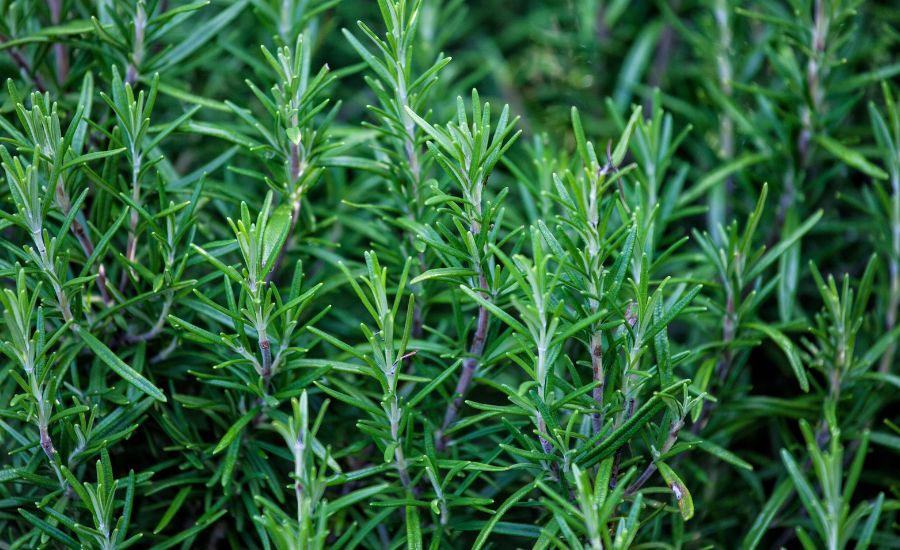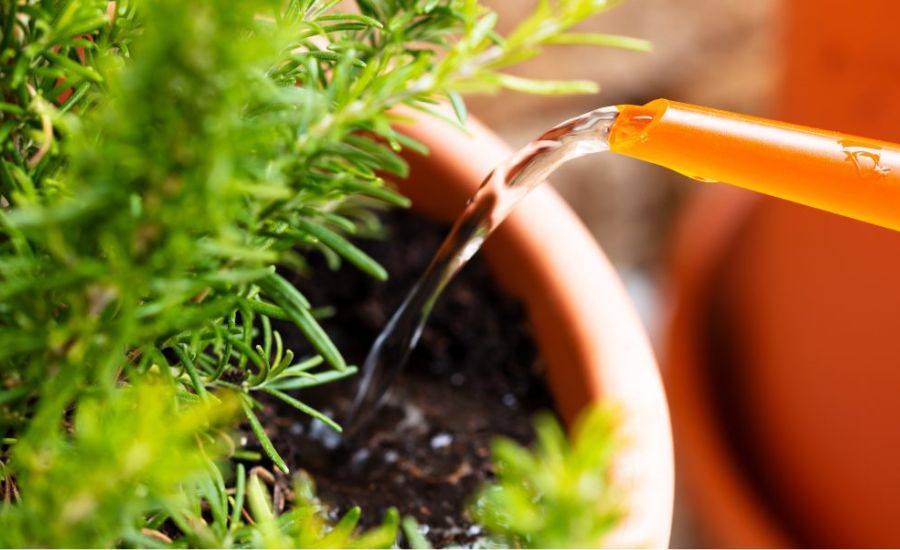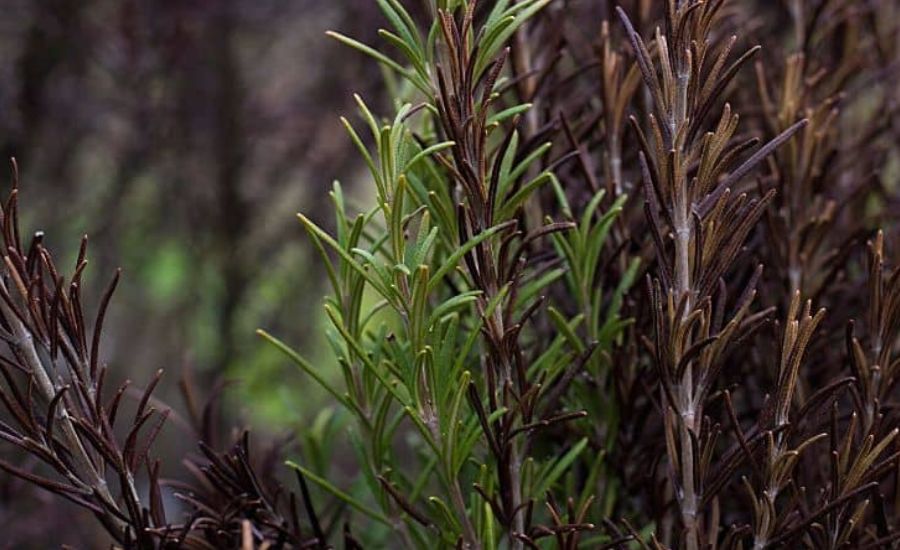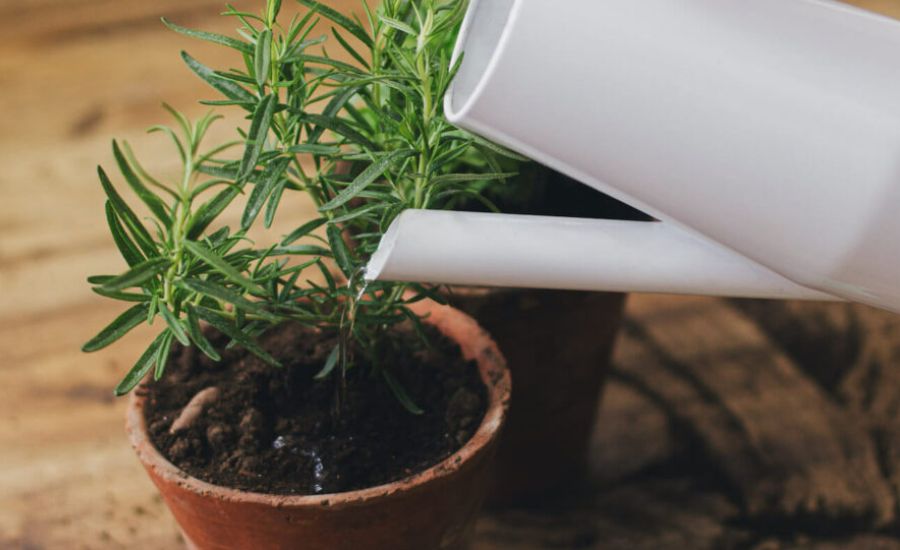There are several reasons why rosemary turning brown. Most of them are associated with improper care of the rosemary plant. More information about the most common causes, as well as methods for correcting the situation, will be discussed in this article.

Contents
Features of the rosemary plant
Before proceeding to study the question, you should familiarize yourself with the main features of the rosemary plant. Plants are considered drought-tolerant.
Therefore, frequent watering of the culture is not required.
Rosemary turning brown if you water the crop heavily, or if you completely exclude water from plant care. In addition, brown leaves of your rosemary may appear for other reasons, including:
- poor soil drainage;
- rainy weather;
- high levels of humidity.

Why rosemary turning brown: causes and correction
Brown leaves of your rosemary plants can appear for various reasons.
Root rot due to overwatering
The rosemary plant can turn brown if you overwater the crop. Rosemary leaves turning brown due to root rot, which is caused by overwatering.
Given that plants are found precisely on the Mediterranean coast, they prefer to grow in low humidity.
To eliminate root rot, it is recommended to create dry conditions for the rosemary plant. Rosemary roots should be in dry soil. Quite often, gardeners water the plant too actively, which causes root rot. Other fungal diseases are not excluded, due to which rosemary leaves turn brown.
Root rot is formed due to excessive watering. Its main symptoms are that rosemary leaves turning brown. After brown spots begin to move to the stems.
The plants themselves become wilting.
If root rot is not treated in time, the rosemary roots die off and the plant dies.
If you notice signs of root rot or other fungi, you should immediately begin treatment. Special preparations help to get rid of root rot.

How to fix the situation?
As you know, brown leaves immediately attract the attention of gardeners.
If you notice that brown leaves have formed on rosemary plants, you should reduce the amount of watering. To prevent root rot, the rosemary plant should be watered no more than once every 2 weeks.
And this is done on the condition that there is no precipitation. To prevent root rot from forming, rosemary plants should only be watered when the soil is dry. Watering in winter should also be avoided.

Poor drainage
Rosemary is best grown in sandy soil. If you plant rosemary in garden soil that has a lot of moisture and poor drainage, you develop a fungal disease, in particular, root rot. When growing rosemary, efforts must be made to dry out damp soil. Otherwise, brown foliage is a regular guest in the herb garden.
If rosemary leaves turning brown, then the problem lies in poor drainage. As already mentioned, rosemary prefers to grow in sandy or rocky soil.
Due to this, the roots do not be constantly in contact with moisture, which eliminates such a fungal disease as root rot.
To grow rosemary on the site, you should create conditions for it that are as close to natural as possible. So that rosemary leaves remain green and do not turn brown, sand should be applied to the garden growing medium. It promotes the penetration of oxygen, which prevents the leaves from turning brown.
High-quality drainage prevents fungal diseases, in particular, root rot.
If you choose to plant a bush in clay soil, moisture is trapped inside.
Therefore, it is necessary to transplant the culture into the prepared mixture. You need to mix 20% sand and 80% potting mix. You can add some compost.
It is best to grow the plant indoors using potting soil. This allows you to monitor the quality of the drainage so that the rosemary leaves do not turn brown due to root rot or another fungal disease. Pots are an optimal alternative to most garden soils.
To grow rosemary well, as already mentioned, you need to add sand and potting mix. You should also pay attention to the roots of rosemary. If the root turns brown, then root rot is developing. You have to trim the affected areas.
Signs of root rot must be removed with tools that have been previously disinfected. It is better to process the tool after each cut. This prevents the fungal disease from spreading further.

Excessive precipitation
It is noted that rosemary leaves turning brown if your area has too much rainfall. They provoke the same problems as abundant watering. This can cause rosemary leaves turning brown. As already mentioned, rosemary prefers to grow in a region with low rainfall.
If your region does not have these conditions, you have to create them. This eliminates the brown rosemary in the plot.
As mentioned, drainage has to be improved using sand or gravel in a region with a humid climate. In regions with a humid climate, you need to plant in pots so that the rosemary does not turn brown.
If you notice brown rosemary in the area, you should move the container to a shelter for 2-3 days.
This allows the brown rosemary to recover. If you planted the plant in the soil on the site, you have to transplant it into a container.

Frost
Brown rosemary can form on the site due to cold weather. The plant grows in a mild climate with warm winters in its natural environment.
If rosemary does not suit your conditions, you have to correct the situation. Rosemary leaves turn brown if the air temperature is too low.
It is important to cut rosemary leaves that have signs of disease. Cut rosemary leaves that have turned brown with a sharp pruner.
This stimulates new growth to restore the bushes. If frosts are expected, plants have to be covered.
This prevents the situation when the leaf turns brown.
If the plants were planted in containers, then it is better to move them indoors before the weather normalizes. If the bushes were planted in the soil, then they need to be covered with a fleece cloth.
This effectively protects the bushes and prevents the rosemary leaves from turning brown. It is also possible to build special caps from improvised materials.
Winter watering rules
To prevent rosemary leaves from turning brown, it is extremely important to normalize the water balance of rosemary.
In winter, plants have a dormant period, so they do not grow so abundantly. Therefore, winter is considered a dry season.
If you water rosemary actively, it freezes.
In cold weather, it freezes and damages the roots. This causes the rosemary leaf to turn brown. Therefore, it is better to cover the bushes with dense materials and reduce the intensity of the water into rosemary.

FAQ
When it comes to growing rosemary, people often experience rosemary leaves turning brown. Therefore, you need to know exactly how to fix everything.
I am very glad that you are actively involved in growing plants because I regularly receive interesting questions and requests for advice from you. Now I have identified the most fascinating in this topic and I want to answer them.
How do you revive a brown rosemary plant?
Rosemary leaves turn brown if you don’t water the bushes enough, or if you water the plants too much.
You can fix everything if you normalize the schedule and watering intensity.
You also need to cut off any bad rosemary leaves, so the bushes can recover. The main thing is to work carefully and use processed tools.
You can also apply liquid fertilizers, which are prepared based on seaweed, to the roots. This accelerates the recovery process.
Can you still use rosemary after it turns brown?
If you notice that the rosemary bush turns brown, this is not a reason to get rid of it.
The leaves change their shade if the metabolism has been disturbed.
However, be prepared for the fact that the taste of the plant and its aroma deteriorates.
Therefore, it is better to refuse to use damaged bushes.
Should I cut back the brown rosemary?
If the rosemary has grown well and the bushes are quite large, you can cut them back. It is recommended to prune in February or early spring.
This prevents the bushes from further damage due to frost.
Pruning rosemary, like other plants, is quite simple. This keeps the plants healthy.
What does overwatered rosemary look like?
If you water rosemary bushes too much, the rosemary leaves turning brown.
Too much water causes rosemary to lose root health.
If the situation worsens, the leaves will completely turn brown, and soon the plant will die.
Results
As you can see, the leaves turn brown if you violate the rules for caring for the crop, or if you plant in the wrong conditions. To normalize the situation, it is recommended to carefully monitor exactly how you water rosemary bushes. It is important to control at what temperature bushes grow.
I hope that after reading this article, you will be able to save your rosemary plants and enjoy their beautiful growth for a long time to come. If you need any clarification, I will be happy to answer in the comments. I will also be glad to interesting advice from you on this issue.
Learn More: What Causes Rosemary Leaves To Turn Brown?


